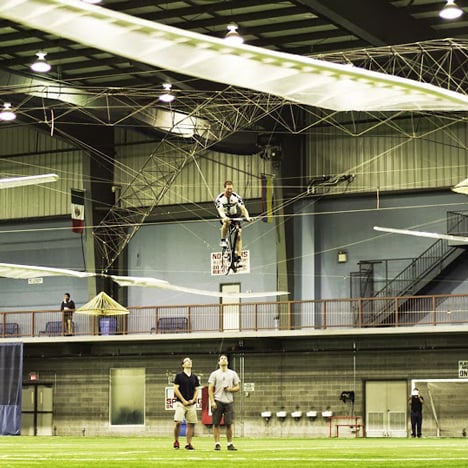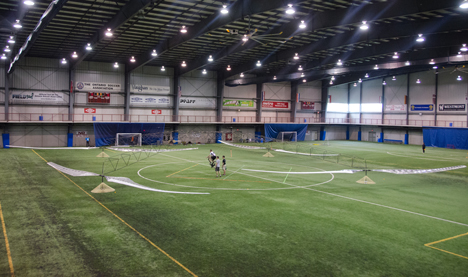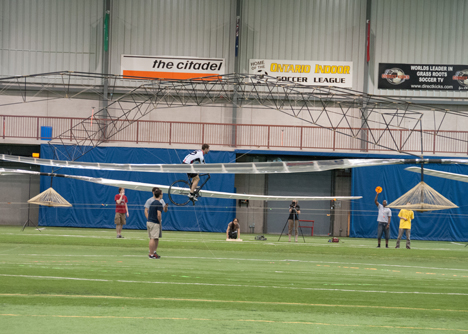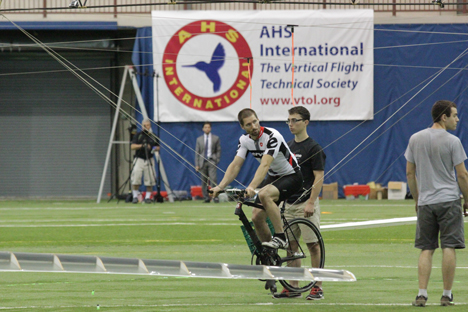
Pedal-powered helicopter claims 33-year-old aviation prize

News: a human-powered helicopter by Canadian startup AeroVelo has become the first winner of a 33-year-old aviation prize, after hovering for 64 seconds and reaching an altitude of 3.3 metres.
AeroVelo co-founders Todd Reichert and Cameron Robertson raised over $34,000 last year via a Kickstarter campaign to build Atlas, a quad-roter helicopter that would be powered by a single person riding a bike.
On 13 June 2013 at 12:43 EDT, the team delivered the record-breaking flight at an indoor soccer stadium in Toronto. This was the very first time a human-powered craft has reached the stringent requirements of aviation pioneer Igor I. Sikorsky's Human Powered Helicopter Competition, originally established in 1980.

To qualify for the prize the aircraft had to hover within a 10 metre-square area for 60 seconds and rise to an altitude of three metres.
American Helicopter Society (AHS) and Sikorsky Aircraft announced last week that AeroVelo had successfully met the requirements and won the $250,000 Sikorsky's Prize. "It's been 33.3 years in the making. Today is the day," tweeted Sikorsky Aircraft.
Here's footage of that record-breaking flight:
Constructed of very light carbon tubes Atlas weighs only 55kg, but spans 50 46.9 metres (162 154 feet). It has four rotating blades and a pedal bicycle at its centre.
"In 18 months, this passionate team went from preliminary design to achieving what many considered impossible; taking down one of the most daunting aviation feats of the past century," the AeroVelo team said on its web page.

The $250,000 prize has remained unclaimed since its inception, despite over 20 human-powered crafts built to attempt the challenge. "When Sikorsky increased the prize to a quarter-million dollars in May 2009, many people were skeptical and felt the challenge was impossible," said Mark Miller, Sikorsky's vice president of research and engineering.

"This is an incredible accomplishment," said Mike Hirschberg, executive director of AHS International. "For a third of a century, the AHS Sikorsky Prize has eluded the best minds and technology available. The technological and theoretical advancements achieved in pursuit of our challenge have been astounding," he adds.
Other record-breaking transport projects unveiled recently include a solar-powered family car and a flying car capable of vertical takeoff and landing. See more transport on Dezeen »
Here's more information from AeroVelo:
Canadian built Human-Powered Helicopter wins elusive $250,000 Prize
AeroVelo, a Toronto based engineering team has won the AHS Igor I. Sikorsky Human Powered Helicopter Challenge and its $250,000 prize. On Thursday, June 13, 2013, Atlas, their human-powered helicopter, completed a record-breaking flight lasting 64 seconds and reaching a height of 3.3 metres.
Conceived by Todd Reichert and Cameron Robertson, along with the AeroVelo team, Atlas spans an incredible 46.9 metres (154 feet) rotor tip to rotor tip, while weighing only 55kgs (122lbs). The record-‐breaking flight was piloted by Reichert, a cyclist and speed skater who has been working with high-performance coaches to develop the power and endurance necessary for a prize-winning flight. According to Reichert "Lifting off and floating above the ground is an incredible feeling, but it’s certainly no easy task. The sheer power required, combined with the high level of mental and physical control, has made this a worthy athletic challenge."

In addition to Reichert as Chief Aerodynamicist and pilot, and Robertson as Chief Structural Engineer, the team is made up of volunteers as well as engineering students who are part of an experiential learning program at AeroVelo. This unique program uses human-‐powered vehicles as a design, innovation and learning platform. "Engineering for a human-engine fosters creativity and ingenuity thus providing an eye-opening experience to our students, and inspiring youth and the general public. Team members will go out into industry and society knowing how to do more with less, ready to solve the formidable challenges facing our generation" said Reichert.
The $250,000 AHS Igor I. Sikorsky Human Powered Helicopter Challenge was established in 1980, and requires a human-‐powered helicopter to have a total flight time of more than 60 seconds, reach a height of over 3 metres during the flight, and stay within a 10 metre by 10 metre box. Since its inception a third of a century ago, dozens of international teams have taken on the challenge, yet the prize has remained elusive.
This is not the first time that Reichert and Robertson have achieved a significant aeronautical milestone; in 2010 they became the first team to successfully build and fly a human-‐powered ornithopter (flapping wing aircraft), named Snowbird, while U of T Engineering students. According to Robertson "Our experience with the Snowbird helped develop the innovative approach and techniques critical for attacking this challenge, and endowed us with the persistence required to overcome many setbacks large and small."
The project is funded by donors in both the academic and corporate communities, including significant contributions from the University of Toronto, U of T Engineering, Bombardier, Pratt & Whitney Canada, Cervelo Cycles, CSR Inc, Kenneth Molson Foundation, the FAI, Bell Helicopter and Cassidy's Transfer & Storage Ltd.
Looking to the future, AeroVelo hopes to tackle the 2 remaining human-‐powered aircraft challenges, which have yet to be won; the Kremer Marathon Competition and the Kremer Sporting Aircraft Competition. In addition, they have their sights set on the World Human-‐Powered Speed Challenge, where streamlined bicycles, reaching speeds over 130 km/hr, compete for the title of world’s fastest human.
AeroVelo is an elite design and innovation lab, focused on high-profile thought-provoking engineering projects.